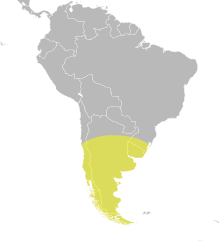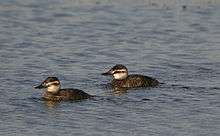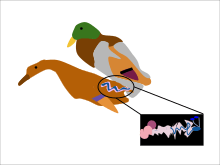Lake duck
The lake duck (Oxyura vittata) is a small, South American stiff-tailed duck. It is also called the Argentine blue-bill, Argentine blue-billed duck,[2] Argentine lake duck, or Argentine ruddy duck.
| Lake duck | |
|---|---|
_RWD.jpg) | |
| Scientific classification | |
| Kingdom: | Animalia |
| Phylum: | Chordata |
| Class: | Aves |
| Order: | Anseriformes |
| Family: | Anatidae |
| Genus: | Oxyura |
| Species: | O. vittata |
| Binomial name | |
| Oxyura vittata (Philippi, 1860) | |
 | |
| Oxyura vittata range | |
| Synonyms | |
Description

The lake duck grows to 36–46 centimetres (14–18 in). Females weigh 510–700 grams (18–25 oz) and males 600–850 grams (21–30 oz). Males can be distinguished from Andean duck (Oxyura ferruginea), a similar species, by being smaller and having a flatter head.[2]

Penis
The lake duck holds the Guinness World Record for having the largest avian reproductive organ, from a specimen in Córdoba, Argentina that had a penis measuring 42.5 centimetres (16.7 in).[3] It also has the longest penis of any vertebrate in relation to body length. The penis, which is typically coiled up in flaccid state, can reach about the same length as the animal itself when fully erect, but more commonly is about half the bird's length.[4][5] It has a soft tip and spiny base.[3] It is theorized that the size of their spiny penises with bristled tips may have evolved in response to competitive pressure in these highly promiscuous birds, removing sperm from previous matings in the manner of a bottle brush.
Although most male birds have no penis,[6] ducks have a long corkscrew penis, and the females have a long corkscrew vagina, which spirals in the opposite direction.[7] The males often try to force copulation, but the complex mating geometry allows the females to retain control—most forced copulations do not result in successful fertilization.[8]
Behavior
Little is known about the lake duck's diet, but it is believed to consist of small invertebrates, seeds, and plant remains. The breeding season varies between countries, occurring from October to January in Argentina. Males produce popping noises and "mechanical rustling noises" for display.[2]
Distribution
The lake duck is a partially migratory species. It lives in bodies of freshwater with large amounts of vegetation, such as wetlands and lakes.[2] It is very widespread, naturally occurring in Argentina, Brazil, Chile, Paraguay, and Uruguay, and having been introduced to Antarctica and the Falkland Islands. It has a stable population of 6,700–67,000, with no major threats. As of 2016, it is listed as a species of least concern on the IUCN Red List.[1]
References
- BirdLife International (2012). "Oxyura vittata". IUCN Red List of Threatened Species. 2012. Retrieved 26 November 2013.CS1 maint: ref=harv (link)
- Carboneras, C.; Kirwan, G. M. "Lake Duck (Oxyura vittata)". Handbook of the Birds of the World Alive. Lynx Edicions. Retrieved 27 April 2019.
- "Largest reproductive organ for a bird". Guinness World Records.
- McCracken, Kevin G. (2000). "The 20-cm Spiny Penis of the Argentine Lake Duck (Oxyura vittata)" (PDF). The Auk. 117 (3): 820–825. doi:10.2307/4089612. Archived from the original (PDF) on 2008-07-05.
- McCracken, Kevin G.; Wilson, Robert E.; McCracken, Pamela J.; Johnson, Kevin P. (2001). "Sexual selection: Are ducks impressed by drakes' display?" (PDF). Nature. 413: 128. doi:10.1038/35093160. PMID 11557968. Archived from the original (PDF) on 2006-09-07.
- Saleh, Anna (September 14, 2001). "Found! The longest bird penis ever". ABC Science.
- Duck genitals locked in arms race | COSMOS magazine Archived 2008-07-25 at the Wayback Machine
- Brennan, Patricia L. R.; Prum, Richard O.; McCracken, Kevin G.; Sorenson, Michael D.; Wilson, Robert E.; Birkhead, Tim R. (2 May 2007). "Coevolution of Male and Female Genital Morphology in Waterfowl". PLOS One. 2 (5): 418. doi:10.1371/journal.pone.0000418. PMC 1855079. PMID 17476339.
External links

